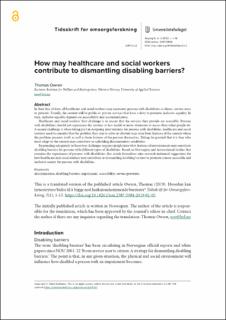| dc.contributor.author | Owren, Thomas | |
| dc.date.accessioned | 2023-03-22T06:46:50Z | |
| dc.date.available | 2023-03-22T06:46:50Z | |
| dc.date.created | 2022-12-10T19:07:26Z | |
| dc.date.issued | 2022 | |
| dc.identifier.citation | Tidsskrift for omsorgsforskning. 2022, 8 (3), 1-16. | en_US |
| dc.identifier.issn | 2387-5976 | |
| dc.identifier.uri | https://hdl.handle.net/11250/3059645 | |
| dc.description.abstract | In their line of duty, all healthcare and social workers may encounter persons with disabilities as clients, service users or patients. Usually, the context will be public or private services that have a duty to promote inclusive equality. In turn, inclusive equality depends on accessibility and accommodation. Healthcare and social workersʼ first challenge is to ensure that the services they provide are accessible. Persons with disabilities should not experience the services as less useful or more strenuous to access than other people do. A second challenge is when taking part in designing interventions for persons with disabilities, healthcare and social workers need to consider that the problem they aim to solve or alleviate may arise from features of the context where the problem presents itself, as well as from features of the persons themselves. Taking for granted that it is they who must adapt to the context may contribute to upholding discriminatory conditions. Responding adequately to these two challenges requires insight into what features of environments may constitute disabling barriers for persons with different types of disabilities. Based on Norwegian and international studies that examine the experiences of persons with disabilities, this article formulates nine research-informed suggestions for how healthcare and social workers may contribute to dismantling disabling barriers to promote a more accessible and inclusive society for persons with disabilities. | en_US |
| dc.language.iso | eng | en_US |
| dc.publisher | Universitetsforlaget | en_US |
| dc.rights | Navngivelse 4.0 Internasjonal | * |
| dc.rights.uri | http://creativecommons.org/licenses/by/4.0/deed.no | * |
| dc.subject | Funksjonshemmende barrierer | en_US |
| dc.subject | Disabling barriers | en_US |
| dc.subject | Diskriminering | en_US |
| dc.subject | Discrimination | en_US |
| dc.subject | Tilgjengelighet | en_US |
| dc.subject | Tilgjengelighet | en_US |
| dc.subject | Funksjonsnedsettelse | en_US |
| dc.subject | Impairment | en_US |
| dc.subject | Tjenesteyting | en_US |
| dc.subject | Service delivery | en_US |
| dc.title | How may healthcare and social workers contribute to dismantling disabling barriers? | en_US |
| dc.type | Peer reviewed | en_US |
| dc.type | Journal article | en_US |
| dc.description.version | publishedVersion | en_US |
| dc.rights.holder | © 2022 The Author(s) | en_US |
| dc.source.pagenumber | 1-16 | en_US |
| dc.source.volume | 8 | en_US |
| dc.source.journal | Tidsskrift for omsorgsforskning | en_US |
| dc.source.issue | 3 | en_US |
| dc.identifier.doi | 10.18261/tfo.8.3.3 | |
| dc.identifier.cristin | 2091503 | |
| cristin.ispublished | true | |
| cristin.fulltext | original | |
| cristin.qualitycode | 1 | |

